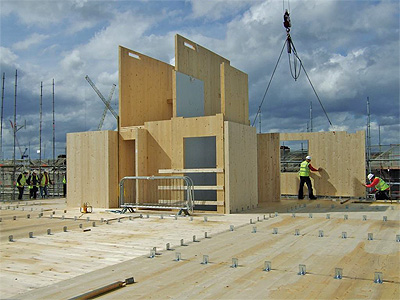Timber Revolution: KLH UK Leading the Way in Sustainable Construction
Changing the code
Providing consultation, design, supply and erection services to the construction industry, KLH UK is tackling the market head on, and changing opinions on the use of timber in construction along the way
KLH UK was formed in 2005 promoting the KLH product, crosslaminated timber (CLT), which is manufactured in Austria. CLT is produced from industrially dried, quick growing spruce boards, with between three and seven layers, stacked in perpendicular layers and glued together over their entire surface.
The business additionally undertakes associated work such as glulam beams & columns and associated structural steelwork. Operating globally, the group has sales partners throughout Europe, Japan, Turkey, Australia and North America. KLH UK is the only part of the group offering a full design, supply and installation package.
 “The market throughout the recession has focused mainly on the commercial drivers, with perhaps less focus on sustainability. However, sustainability sits nicely alongside commercial as CLT offers added value to our clients by examples such as the reduction in the need for PV by providing a fabric first approach to carbon reductions or the inherent air tightness of the structure from precision cutting of panels and openings providing a more efficient building in terms of operational carbon use. Although the market has been commercially driven, we are still able to compete on the basis of the overall programme advantages that we can bring by using CLT,” explains Nic Clark, managing director. Until now, the company’s market has been very much focused on education, but there is a growing requirementfor multi-occupancy residential, student accommodation and hotels, alongside the educational builds. “The market is definitely improving with new enquiries surrounding residential projects coming through,” he adds.
“The market throughout the recession has focused mainly on the commercial drivers, with perhaps less focus on sustainability. However, sustainability sits nicely alongside commercial as CLT offers added value to our clients by examples such as the reduction in the need for PV by providing a fabric first approach to carbon reductions or the inherent air tightness of the structure from precision cutting of panels and openings providing a more efficient building in terms of operational carbon use. Although the market has been commercially driven, we are still able to compete on the basis of the overall programme advantages that we can bring by using CLT,” explains Nic Clark, managing director. Until now, the company’s market has been very much focused on education, but there is a growing requirementfor multi-occupancy residential, student accommodation and hotels, alongside the educational builds. “The market is definitely improving with new enquiries surrounding residential projects coming through,” he adds.
KLH UK has worked on a number of impressive projects such as the UK’s tallest timber tower: Murray Grove, and the UK’s largest CLT structure: William Perkins Academyin Greenford, where 23,000 sq metres of timber was used in the construction. The company was also involved in the formatting of the design and supply for the world’s tallest tower in Melbourne, Australia, and recently completed Kingsgate House which was the world’s first major construction project to achieve PEFC Project Certification.
“We have a team of engineers focused on providing scheme designs, temporary works design, and full designs and connection drawings for our projects. A large aspect of their work is converting existing tender designs or architectural concepts into a CLT design, taking into account the loading, spans, the fire requirements and vibration frequency requirements,” explains Nic.
The next stage is the production of a 3D model detailing the design. Once agreed with the customer, a full detailed design is produced, including the connection design. A team of technicians then produces a model that the factory can work to, manufacturing and cutting the individual panels. Information detailing all the cuts for the windows and doors, the chases for the electrical installations is inputted into the CNC machines at the factory in Austria.
The panel is produced in a standard size with the individual wall, floor & roof elements cut out and loaded for delivery in an order that suits the sequence of erectionon site. “We use subcontract teams of improved installers for the site installation. However we do see askills shortage in timber engineering and as a measure to tackle this we have sponsored a post-graduate at Napier to do a Masters degree in timber engineering for the 2014/2015 term, as well as having a home-grown approach to training.”
“Timber engineers are rare in the market so we recruit engineers and provide on-the-job training in the Euro-code and timber design,” says Nic. Discussing training and attracting the right candidates into the industry he adds: “We need to look at the skills shortage that exists and as an industry we need to begin developing that. We are working closely with the University of Bath to generate interest in timber engineering but it really requires a drive on a more macro level. Young talent needs to see that there is a future in building in timber, and we need to generate some  impressive structures to gain their interest. Some Government intervention into research & training would lead the way to more sustainable construction taking place in the UK.”
impressive structures to gain their interest. Some Government intervention into research & training would lead the way to more sustainable construction taking place in the UK.”
With the material supply chain fully in-house its clients are given the confidence in the process, offering a collaborative approach based on skills and expertise throughout the process. As a straightforward thinking business, it understands that the technology and process is new and it is important to be clear with the customer about the process and its design throughout all stages of the project.
“Bringing a new technology to the market has brought with it many challenges. People are happy with what they know and are very reluctant to try anything new, but it is a hurdle that we have worked on overcoming and we can almost see the finishing line. There is a large proportion of the design community that is very interested in sustainability so that is where some of the momentum is and that has been fantastic. We know many contractors have a sustainability agenda but every so often we are confronted with negative views, but it is interesting to see their reaction at the finished article; they almost always impressed, if not converted,” explains Nic.
There are still some hurdles to overcome and KLH UK has recently invested money into testing and research into fire during the construction phase with the involvement of the HSE. “We are also meeting some resistance from the insurance market, specifically around the hotel sector where they are concerned about insuring the larger hotel schemes, which is odd given they insure CLT hotels on the continent ” Nic points out. However one factor that is clearly a challenge amongst subcontractors such as KLH UK is the struggle it faces in the payments terms with main contractors, typically waiting in excess of two months from manufacture before receiving payment.
“The future looks positive, there is massive opportunity which comes from the shortage of housing in the southeast and London, and as the benefit of CLT becomes more recognised contractors are looking to use this model. The design works really well, it is quick and provides very good value for money. We are always investing in the development of the product, currently looking at hybrid offers so that we can supply to different sectors such as the retail or the commercial sectors, where typically the open plan spans required are beyond the economical reach of the CLT. The vision for CLT as a product is that it becomes fully recognised as a mainstream construction material, alongside concrete and steel work. We want the product to be considered as a first choice, not simply an alternative,” Nic concludes.
KLH UK Ltd
Services: Specialist supplier of cross-laminated timber panels